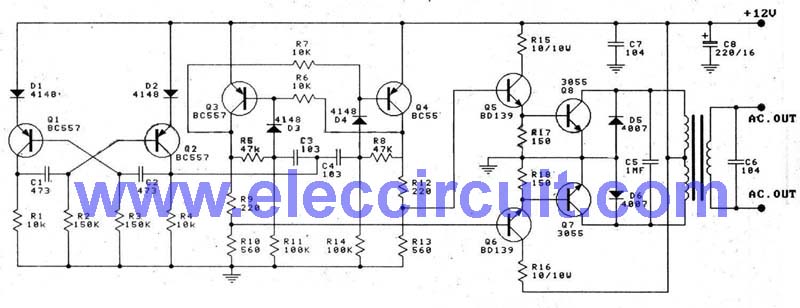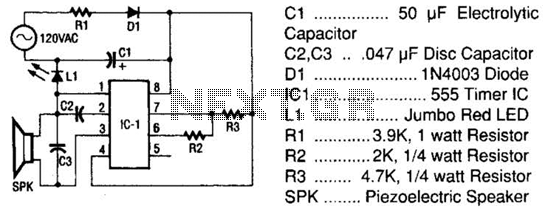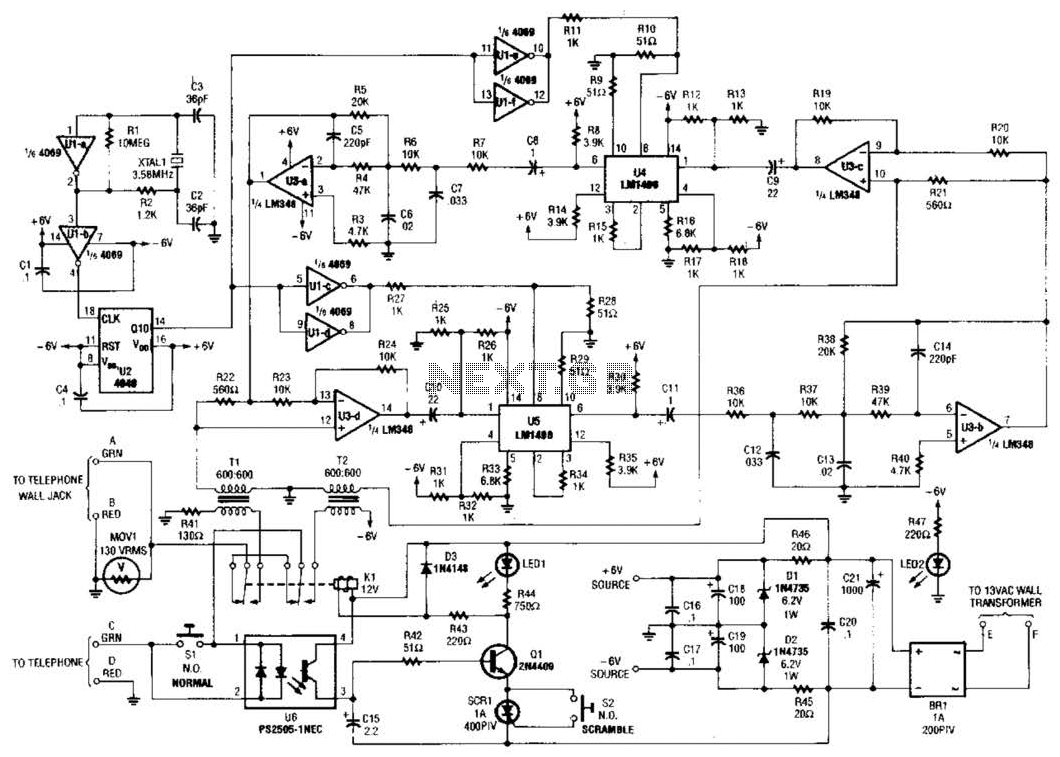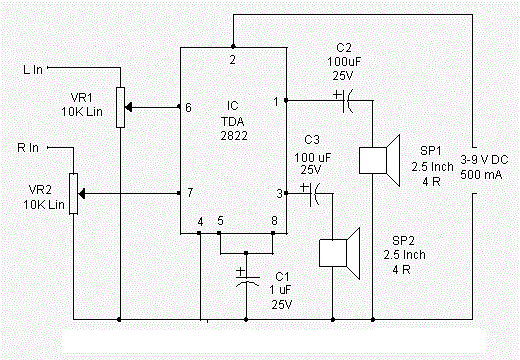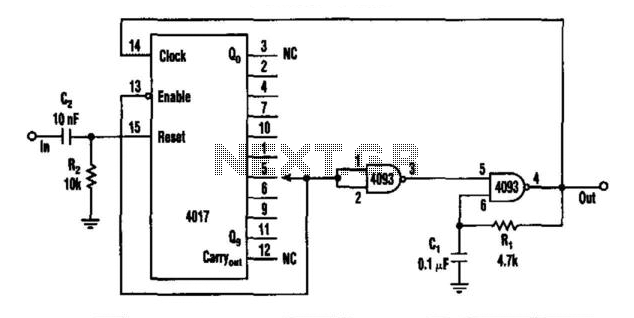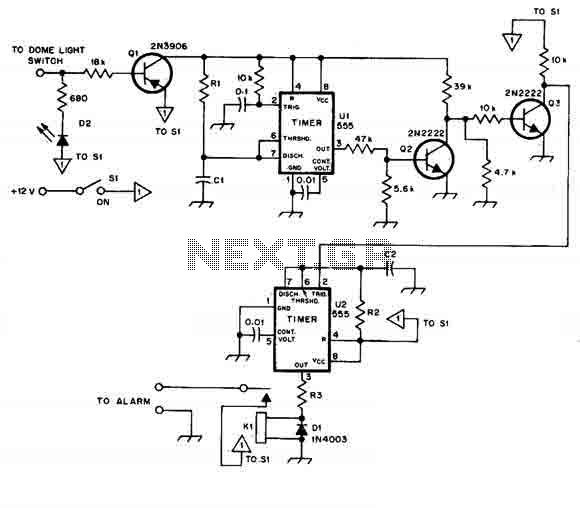
Chizuru 100Hz channel frequency pulse charging electric bike battery circuit
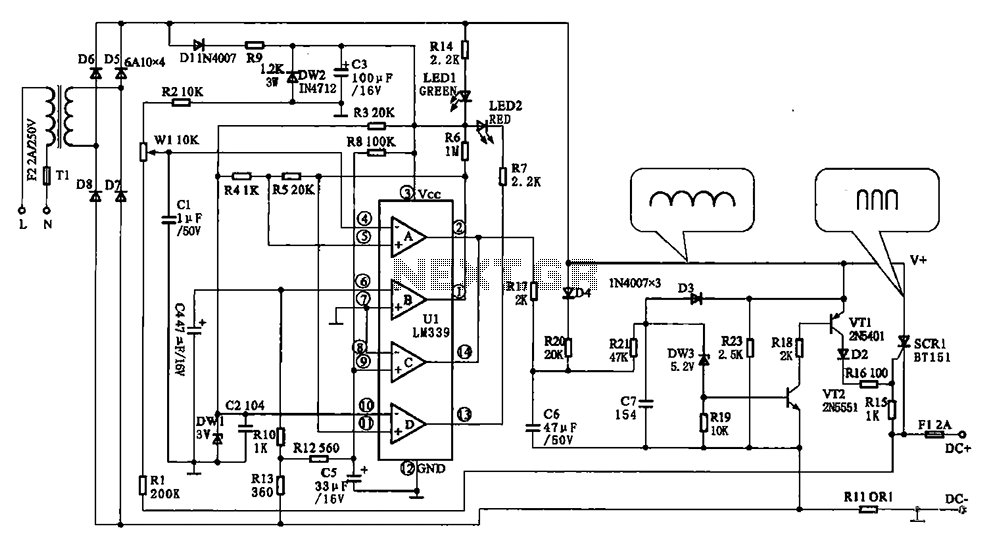
The Chizuru 100Hz channel frequency pulse charging circuit for electric bike batteries is designed to manage the charging process efficiently. It features a step-down transformer (Tl) and a bridge rectifier formed by diodes D5 to D8. The output ripple current is managed through diode Dl, resistor R9, and diode DW2. The charging switch is a thyristor (SCR1), which activates to charge the battery. The power supply generates a 100Hz alternating current (AC), which transitions to direct current (DC) with zero crossing turn-off, resulting in a pulsed charging mechanism. The charging current waveform is illustrated in Figure 2-77. The charging switch is controlled by components DW3, VT1, and VT2, with each cycle producing a pulsating DC signal. When the positive voltage (v+) reaches a certain threshold, DW3 enters reverse breakdown, allowing v+ to pass through D4, R20, R21, and DW3, which activates VT2 and subsequently SCR1 to charge the battery. If the voltage at the dividing point formed by R20 and R21 is grounded, SCR1 will not activate. The protection circuit halts charging by manipulating the potential at the R20 and R21 dividing point. Battery voltage is monitored by a pressure limiting circuit comprising UIA, Rl, Wl, and R2. When the battery voltage reaches 43.5V, UIA triggers a flip, allowing conduction through R17 to the dividing point, thereby stopping the charging output. The charging current limit is monitored by UIC and resistors R12 and R13. If the charging current exceeds the set limit, the potential drop across sampling resistor Rll will cause UIC to flip, resulting in the same low potential at the R20 and R21 points to stop the charging output. The charging state is detected by UIB, R10, and R13. If the charging current surpasses a predetermined value, the potential drop across Rll will prompt UIB to flip, increasing the output high potential, which signals the charging status display driver UID to activate, turning off the charge lamp LED2. The increased potential at UIB also raises the reference voltage for UIA, adjusting the threshold for battery voltage limiting, which narrows the charging pulse current even if the charging current decreases.
The Chizuru 100Hz pulse charging circuit is designed to efficiently charge electric bike batteries while ensuring safety and reliability. The step-down transformer (Tl) reduces the input voltage to a suitable level for battery charging. The bridge rectifier, composed of diodes D5 to D8, converts the AC output of the transformer into a pulsating DC current, which is critical for the charging process. The use of a thyristor (SCR1) as a charging switch allows for controlled charging cycles, where the SCR is turned on when the conditions are met, ensuring that the battery receives the correct voltage and current.
The circuit employs a feedback mechanism to monitor battery voltage and current, utilizing a combination of operational amplifiers and resistors. The battery voltage limiting circuit, which activates at 43.5V, is essential for preventing overcharging, a common issue in battery management systems. The current limit detection circuit ensures that charging is halted if the current exceeds a safe threshold, protecting both the battery and the circuit components from potential damage.
Additionally, the charging state detection circuit provides visual feedback through the LED indicator, allowing users to easily determine the charging status. This feature enhances user experience and ensures that the charging process is transparent. The overall design emphasizes safety, efficiency, and user-friendliness, making it suitable for electric bike applications. Chizuru 100Hz channel frequency pulse charging electric bike battery circuit Shown as Chizuru 1.00 I-Lz letter frequency pulse electric bicycle battery charging circuit. Freque ncy transformer Tl is a step-down transformer, D5 ~ D8 form a bridge rectifier, the output ripple current through Dl, R9, DW2 control circuitry. Way thyristor SCR1 is charging switch, which is turned on to charge the battery, since the power supply is shaped bread ioo Hz AaC move DC, zero crossing turn-off, so the charger 100 FIz pulse charger, the charging current waveform shown in Figure 2-77.
Charging switch is controlled by DW3, VT1, VT2, each cycle in bread shaped IOOH pulsating DC, v + potential rises to when DW3 reverse breakdown, v + through D4, R20, R21, DW3 make VT2 conduction, thereby enabling rri conduction, v + ~ vri, D2 make SCR1 is turned on when the battery voltage is higher than the potential v +, v + on the battery charge. However, if R20 and R2J dividing point grounding, v + another high potential, DW3, VI2, VI2, SCR1 is not turned on.
Protection circuit and charging stop is the use of the R20 and R21 dividing point potential to achieve low off the charge output. Battery voltage is detected by the pressure limiting UIA, Rl, Wl, R2 composition, when the battery voltage rises to 43.5V when, UIA flip, its feet on the ground conduction through R17 to R20 and R21 dividing point potential to achieve low close charging output.
Charge current limit is detected by the UIC, R12, R13 composition roar when the charging current exceeds the limit value, the current sampling resistor Rll left to reduce the potential to make UIC flip its feet on the ground! Conduction, the same will be R20 and R21 stars realize the potential of low pressure point off the charge output.
Charging state detected by the UIB, R10, R13 composition, the charge current exceeds a predetermined value, the current sampling resistor Rl1 potential drop left lower column UIB flip it O feet into high potential, prompting the charging status display driver UID flip it! pin potential becomes high, the charge lamp LED2 is off. O feet in potential UIB becomes high, also increased the UIA reference voltage, which increases the battery voltage limiter threshold voltage value, the charging pulse current is shaped punch left narrowed, even if the charging current drops.
The Chizuru 100Hz pulse charging circuit is designed to efficiently charge electric bike batteries while ensuring safety and reliability. The step-down transformer (Tl) reduces the input voltage to a suitable level for battery charging. The bridge rectifier, composed of diodes D5 to D8, converts the AC output of the transformer into a pulsating DC current, which is critical for the charging process. The use of a thyristor (SCR1) as a charging switch allows for controlled charging cycles, where the SCR is turned on when the conditions are met, ensuring that the battery receives the correct voltage and current.
The circuit employs a feedback mechanism to monitor battery voltage and current, utilizing a combination of operational amplifiers and resistors. The battery voltage limiting circuit, which activates at 43.5V, is essential for preventing overcharging, a common issue in battery management systems. The current limit detection circuit ensures that charging is halted if the current exceeds a safe threshold, protecting both the battery and the circuit components from potential damage.
Additionally, the charging state detection circuit provides visual feedback through the LED indicator, allowing users to easily determine the charging status. This feature enhances user experience and ensures that the charging process is transparent. The overall design emphasizes safety, efficiency, and user-friendliness, making it suitable for electric bike applications. Chizuru 100Hz channel frequency pulse charging electric bike battery circuit Shown as Chizuru 1.00 I-Lz letter frequency pulse electric bicycle battery charging circuit. Freque ncy transformer Tl is a step-down transformer, D5 ~ D8 form a bridge rectifier, the output ripple current through Dl, R9, DW2 control circuitry. Way thyristor SCR1 is charging switch, which is turned on to charge the battery, since the power supply is shaped bread ioo Hz AaC move DC, zero crossing turn-off, so the charger 100 FIz pulse charger, the charging current waveform shown in Figure 2-77.
Charging switch is controlled by DW3, VT1, VT2, each cycle in bread shaped IOOH pulsating DC, v + potential rises to when DW3 reverse breakdown, v + through D4, R20, R21, DW3 make VT2 conduction, thereby enabling rri conduction, v + ~ vri, D2 make SCR1 is turned on when the battery voltage is higher than the potential v +, v + on the battery charge. However, if R20 and R2J dividing point grounding, v + another high potential, DW3, VI2, VI2, SCR1 is not turned on.
Protection circuit and charging stop is the use of the R20 and R21 dividing point potential to achieve low off the charge output. Battery voltage is detected by the pressure limiting UIA, Rl, Wl, R2 composition, when the battery voltage rises to 43.5V when, UIA flip, its feet on the ground conduction through R17 to R20 and R21 dividing point potential to achieve low close charging output.
Charge current limit is detected by the UIC, R12, R13 composition roar when the charging current exceeds the limit value, the current sampling resistor Rll left to reduce the potential to make UIC flip its feet on the ground! Conduction, the same will be R20 and R21 stars realize the potential of low pressure point off the charge output.
Charging state detected by the UIB, R10, R13 composition, the charge current exceeds a predetermined value, the current sampling resistor Rl1 potential drop left lower column UIB flip it O feet into high potential, prompting the charging status display driver UID flip it! pin potential becomes high, the charge lamp LED2 is off. O feet in potential UIB becomes high, also increased the UIA reference voltage, which increases the battery voltage limiter threshold voltage value, the charging pulse current is shaped punch left narrowed, even if the charging current drops.
Warning: include(partials/cookie-banner.php): Failed to open stream: Permission denied in /var/www/html/nextgr/view-circuit.php on line 713
Warning: include(): Failed opening 'partials/cookie-banner.php' for inclusion (include_path='.:/usr/share/php') in /var/www/html/nextgr/view-circuit.php on line 713
